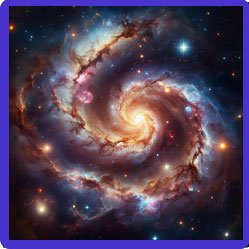
Space
Space is the vast, empty expanse beyond Earth's atmosphere where stars, planets, moons, asteroids, and comets exist. In physics, space is studied to understand the universe, its objects, and their interactions.
The life cycle of a star
Nebula (birth)
Stars begin their lives as clouds of gas and dust called nebulae. These nebulae are vast regions in space where gravity pulls gas and dust together. Over time, the material in the nebula starts to clump together due to gravity, forming a dense core known as a protostar.
Protostar
As the protostar continues to accumulate mass, its core heats up and pressure increases. Eventually, the temperature and pressure become so high that nuclear fusion begins in the core. Nuclear fusion is the process where hydrogen atoms combine to form helium, releasing energy in the form of light and heat. Once nuclear fusion starts, the protostar becomes a main sequence star.
Main sequence star
A main sequence star is in the prime of its life. It fuses hydrogen into helium in its core, releasing energy that keeps the star shining brightly. Our Sun is currently a main sequence star. The amount of time a star spends on the main sequence depends on its mass. More massive stars have shorter main sequence lifetimes than less massive stars.
Red Giant or Red Supergiant
When a main sequence star runs out of hydrogen fuel in its core, it begins to evolve into a red giant or red supergiant. For smaller stars like our Sun, they expand into red giants. During this phase, the outer layers of the star expand outward, and the star becomes larger and cooler. The core contracts and heats up, causing the outer layers to expand.
Planetary Nebula or Supernova
For stars like our Sun, after the red giant phase, they shed their outer layers, forming a planetary nebula. The core of the star remains behind as a white dwarf, a dense remnant of the star's core.
However, for more massive stars, they undergo a supernova explosion when they run out of fuel. This explosion is one of the most energetic events in the universe, and it disperses heavy elements into space.
White Dwarf & Black Dwarf
After shedding its outer layers and becoming a planetary nebula, the remaining core of a low to medium-mass star becomes a white dwarf. A white dwarf is extremely dense and hot but no longer undergoes nuclear fusion. It gradually cools over billions of years. Eventually, it gives off such little energy that it becomes a black dwarf.
Neutron Star or Black Hole
For massive stars that become supernovas, the core may collapse further to become a neutron star or a black hole, depending on its mass. In a neutron star, the outer layers of dust and gas are thrown into space leaving a very dense core. A black hole has a super dense point in space that not even light can escape.
What makes up our Solar System?
The Sun
At the center of our solar system is the Sun, a massive, glowing ball of gas primarily composed of hydrogen and helium. The Sun provides light and heat to all the planets and other objects orbiting around it.
Planets
There are eight planets in our solar system, divided into two main groups:
- Inner Planets (Terrestrial Planets): These are the four planets closest to the Sun: Mercury, Venus, Earth, and Mars. They are relatively small, rocky planets with solid surfaces.
- Outer Planets (Gas Giants): These are the four planets farthest from the Sun: Jupiter, Saturn, Uranus, and Neptune. They are much larger than the inner planets and composed mostly of gases, such as hydrogen and helium.
Dwarf Planets and Asteroids
Apart from the eight planets, our solar system also contains dwarf planets, which are similar to planets but smaller in size. Pluto, Eris, Haumea, Makemake, and Ceres are examples of dwarf planets. Additionally, there are millions of smaller rocky or metallic objects called asteroids, which mostly orbit the Sun in a region called the asteroid belt between Mars and Jupiter.
Moons
Many of the planets in our solar system have moons, which are natural satellites that orbit around them. For example, Earth has one moon, while Jupiter has over 70 moons.
Comets and Meteoroids
Our solar system also contains comets and meteoroids. Comets are icy bodies that orbit the Sun in elongated paths, and when they approach the Sun, they develop tails made of dust and gas. Meteoroids are smaller rocky or metallic bodies that orbit the Sun, and when they enter Earth's atmosphere, they burn up and create streaks of light called meteors or shooting stars.
Artificial satellites
Artificial satellites are man-made satellites that orbit the Earth. These satellites are launched into space using rockets and are designed to perform various functions, such as communication, navigation, Earth observation, scientific research, and more.
What is Dark Matter?
When astronomers study galaxies, they find that the stars at the edges move much faster than expected based on the amount of visible matter (stars, gas, dust) inside the galaxy. According to Newton’s laws of motion and gravity, galaxies should not hold together if only visible matter was present — they should fly apart.
To explain this, scientists think there must be an invisible type of matter that does not give off light or any other form of radiation. This is called dark matter. Even though we can’t see it directly, we know it must exist because of the gravitational effects it has on galaxies and galaxy clusters.
Current estimates suggest that dark matter makes up about 27% of the universe, while normal matter (everything we can see) is only about 5%. The rest is thought to be dark energy, another mysterious force linked to the accelerated expansion of the universe.
Dark matter remains one of the biggest mysteries in physics — we know it’s there, but we don’t yet know exactly what it’s made of.
Revision Notes

The Cornell method is like a supercharged note-taking system that helps you ace your revision!
Print out our blank revision notes pages to help you revise.
How to make effective revision notes with the Cornell method.
Exam Questions & Answers

Download and print off practice our FREE worksheet with exam style questions on Cell Biology.
What is Red-Shift?
When we look at light from distant galaxies through telescopes, we notice that the light has shifted towards the red end of the spectrum. This is called red-shift. It happens because the galaxies are moving away from us, and as they do, the wavelengths of light get stretched, just like the sound of an ambulance siren seems lower as it moves away (the Doppler effect).
Astronomers have found that the further away a galaxy is, the bigger its red-shift. This means distant galaxies are moving away faster than nearby ones. This relationship is described by Hubble’s Law and gives strong evidence that the universe is expanding in all directions, not staying still.
What is The Big Bang?
The Big Bang theory is the most widely accepted explanation for the origin of the universe. It states that around 13.8 billion years ago, all space, time, matter, and energy were concentrated in a single, tiny, extremely hot and dense point. Then, in a rapid expansion, the universe began to grow, and it has been expanding and cooling ever since.
The key evidence supporting the Big Bang includes:
- Red-shift of galaxies – showing that the universe is expanding.
- Cosmic Microwave Background Radiation (CMBR) – faint radiation detected everywhere in space, thought to be leftover heat from the early universe.
- The relative amounts of light elements (hydrogen and helium) found in the universe, which match predictions made by the Big Bang model.
The theory doesn’t describe what caused the Big Bang, but it provides a strong scientific model for how the universe developed from a hot, dense beginning into the vast cosmos we see today.
Also see Forces, Atomic Structure
Links for Learning
Bitesize: The life cycle of a star.
School Observatory: The life cycle of a star.
Sciencing: The life cycle of a star.
Nasa: The life cycle of a star.
Bitesize: The Solar System.
Pass my exams: The Solar System.
ESA: The Big Bang.
Bitesize: Red-shift.
Bitesize: The life cycle of a star test.
Bitesize: The Solar System test.
Bitesize: The expanding Universe test.
Revision Notes

The Cornell method is like a supercharged note-taking system that helps you ace your revision!
Print out our blank revision notes pages to help you revise.
How to make effective revision notes with the Cornell method.
Why Do I Need to Know About Space?
In Everyday Life
- Technology: Many technologies we use daily, like GPS, weather forecasting, and satellite communications, rely on our understanding of space.
- Navigation: The GPS in your phone or car uses satellites orbiting Earth to help you find your way.
- Weather Forecasting: Satellites monitor weather patterns, helping meteorologists predict storms and other weather events.
- Global Communication: Satellites enable television broadcasts, internet access, and phone calls across the globe.
In Science & Physics Careers
- Astronomy & Astrophysics: Studying space helps scientists understand the universe's origins, structure, and evolution.
- Engineering: Space missions require engineers to design spacecraft, rockets, and satellites, leading to advancements in technology.
- Environmental Science: Monitoring Earth's environment from space helps track climate change, deforestation, and pollution.
- Education & Research: A solid understanding of space physics can lead to careers in teaching, research, and space exploration.


